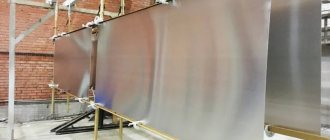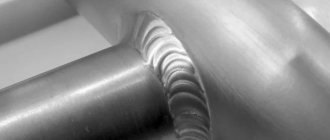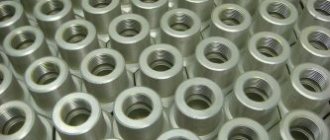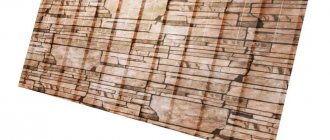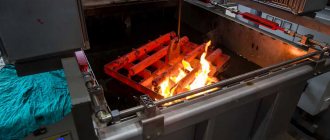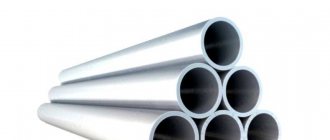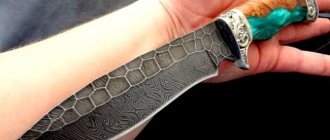Anodizing metal at home - methods
The essence of the process of anodizing metal at home will be the build-up of an oxide coating, which on aluminum and alloys will act as protection against environmental influences. Another name would be anodic oxidation. Moreover, oxidation is used to improve the beauty of the appearance of products.
Please note that surface defects will be eliminated - small scratches, chips. You can also imitate coating with precious metals or improve adhesion properties. The coating can be applied not only during the production process, but also at home.
Processing aluminum at home is very popular among home craftsmen. In products that are subjected to anodic oxidation, the stability of the protective coating increases.
What is anodized metal surface
The name anodization is a process that occurs when using an electrolyte and electric current of various sizes and allows you to obtain a durable oxide foam on the product, which increases the strength of steel and provides protection against corrosion. Strength and mechanical characteristics vary depending on the composition of the metal, the density and type of electrolyte, the magnitude of the anodic and cathodic effects, calculated using special equations.
The protective coating itself is not applied, but is formed from the iron itself during an electrochemical reaction. The technology used at home looks schematically like this:
Scheme of the anodizing process at home
- Electrolyte is poured into a dielectric (non-conducting) container.
- A power supply is taken that can provide the required DC voltage at the output (this can be a battery or several batteries connected in electronic circuits).
- The “+” clamp is connected to the object being processed, and the object is immersed in a container with the solution.
- The “–” clamp is attached to a lead or stainless steel plate and is also lowered into the liquid.
- An electric current of the required magnitude is connected, according to the electrochemical equation. Thanks to it, oxygen begins to be released on the surface of the product, promoting the formation of a durable protective film.
What is anodizing called and why is it used?
In appearance, aluminum is a silver-white metal. But it easily oxidizes in air, reacting with oxygen, and therefore looks gray in life. The oxide film that forms on the surface is too thin and fragile to truly protect the aluminum product from the effects of the external environment.
Therefore, anodizing technology was developed - this is a process that results in the formation of an oxide film of Al2O3. It is denser and stronger than what is obtained naturally; a natural modification of the oxide is corundum, a mineral second only to diamond in hardness.
To obtain a protective layer, the metal is immersed in an acidic electrolyte solution and a direct current is passed through the system. The process is called anodizing (in other words, anodic oxidation or anodic oxidation) since aluminum acts as an anode. The technology is used when it is important to perform the following tasks:
- Maintaining the integrity and uniformity of the coating during operation (the service life of the coating is 20 years).
The coating can be given any shade Source twimg.com
- Resistance to corrosion processes at a high level.
- Preservation of external aesthetics. The coating evens out scratches, dents and other minor defects on the metal surface.
Advantages of anodized metal
Anodic oxidation (anodizing) of various metals, carried out at home, is, of course, much inferior to that carried out using industrial equipment. But, nevertheless, it can provide the product with a number of advantages:
- Increase resistance to corrosion - due to the fact that the oxide film prevents moisture from penetrating the metal base, providing reliable protection. The use of this process on quickly rusting household items or disks and parts of household appliances can significantly extend their service life.
- Increase the strength of metal and steel: the oxidized coating is much more resistant to mechanical and chemical damage.
- Dishes treated in this way are non-toxic, resistant to prolonged heating, and food does not burn on them.
- After anodizing treatment, metal products acquire dielectric properties (they do not conduct current at all or almost not).
- Possibility of electroplating of another metal (chrome, titanium). Made with your own hands, it can significantly increase the mechanical strength characteristics or improve the decorative qualities (gold plating).
In addition, the process allows for decoration. You can do color anodic oxidation. This result can be obtained by changing the equations of the applied current and the density of the electrolyte (this is possible when anodizing titanium and other hard materials) or by using paint (more often for aluminum and other soft metals, but this process is also used on hard substrates). Objects painted in this way have a more even and deeper color.
The industrial method provides higher coating strength, the ability to carry out deep anodizing with the simultaneous application of cathodic electrochemical foam, which provides additional protection against corrosion. But even anodic-cathode treatment carried out at home will help make disks or other parts of moving mechanisms more durable and wear-resistant.
Metal anodizing technology and its features
An attractive appearance and increased strength properties of a metal surface can be achieved by using special electrochemical reactions. One of these methods is anodizing the metal, during which a protective oxide film is formed on the surface, giving the material additional qualities.
Features of anodized
This procedure is widely used on an industrial scale; in addition, you can independently oxidize steel, aluminum or copper at home. The latter option will differ from the professional process, but it is convenient for processing small parts.
Products that have a film formed on their surface after anodizing have the following characteristics:
- increased resistance to corrosion;
- the strength of materials such as steel and aluminum increases;
- the product becomes non-toxic;
- lack of ability to conduct current;
- the prepared surface is suitable for further processing using galvanic coating.
The procedure of anodizing metal is used for the production of cookware - products processed by this method do not burn on the stove and are safe for cooking. Materials with an oxide film are used in the manufacture of some tools, building materials, lighting devices, and household items. In addition, silver products are processed.
Color anodizing is widespread, which allows you to give parts a variety of decor. Products painted in this way have a more even and deeper color.
The anodized surfaces of tools and devices do not crack during use, maintaining their original appearance for a long time. In addition, the plane becomes stronger, which allows it to withstand increased loads and mechanical stress.
How does the anodizing process work?
The whole procedure consists of three stages of work: preparing the metal, its chemical treatment and fixing the coating to the surface. We propose to take a closer look at each of these phases using the example of processing a material such as aluminum:
- Preparatory stage. The metal profile is cleaned mechanically, after which it is polished and degreased. This must be done so that the coating is firmly fixed to the base. Next comes the use of alkalis. The part is placed in the solution for some time for etching, after which it is transferred to an acidic liquid, where the aluminum is brightened. The final stage of anodic preparation is the complete washing of parts from residual alkali and acid.
- Chemical reaction. The prepared product is placed in an electrolyte. It is a solution of acid to which a current is connected. The material to be anodized is most often treated with sulfuric acid, and its oxalic analogue is used to achieve color. A successful result is achieved with the correct temperature and current density. Hard anodizing involves the use of low temperatures, but if the goal is to obtain a soft and porous film, the performance increases.
- Stage of fixing the coating. The resulting aluminum parts with the film formed on them have a porous appearance, so they need to be strengthened. Several methods are used for this: dipping the product in hot water, treating with steam or a cold solution.
For further color painting of the product, there is no need to fix the anodizing. Existing paints and varnishes adhere perfectly to the porous surface, forming excellent adhesion to it.
It is worth noting that metals are coated with such anodizing at industrial enterprises. A particularly durable type of coating can be achieved with a hard type of procedure. This material is used in automobile production, aircraft construction and construction.
Method of procedure at home
When starting anodizing yourself at home, you must first prepare all the tools:
- container for placing the product;
- batteries with a capacity of 9 V (several pieces, depending on the desired result);
- aluminium foil;
- cable with good insulation;
- electrolyte solution;
- ticks.
As an experimental experience, you can try processing the bolts. The thickness of the finished coating is approximately 0.05 mm. Products must be prepared in advance. If stainless steel elements were selected, degrease and sand them in advance.
Prepare an electrolytic solution. To do this you will need sulfuric acid and distilled water. You can purchase acid for the electrolyte at auto stores that specialize in battery repair. The proportions of water and acid should be the same, but you should not use an undiluted substance.
It will take longer to achieve a black metal color than a light or bronze result.
First, etch the part in lye to prepare it. After this, place the part in a solution with electrolyte and connect the current. It is important to use a thermometer to monitor the temperature and ensure that the readings do not drop. When the level reaches the lower levels, it is necessary to end the process.
On video: anodizing in an alkali solution.
Precautions and technical advice
To obtain an anode film yourself, it is important to follow some safety measures that will help maintain health and carry out the procedure correctly:
- When working, use personal protective equipment for your skin – gloves, mask. Cover your eyes with safety glasses if necessary: during the process of obtaining anodized metal, a lot of heat is released, and the solution can splash onto the body.
- Choose the right container for processing: it can be a plastic container or an old enamel bathtub without chips.
- After etching the product, place it in clean water in order to have time to prepare for the next stage.
- Use aluminum conductors for work: silver, steel or copper parts must be hung on a special bar to make removing the products easier.
- The thickness of the cable must correspond to the current strength. If the indicators were selected incorrectly, the solid variation of the procedure will be unsuccessful, as a result of which the metal will simply dissolve.
- To achieve a black color of steel, sodium nitrate is used; parts in the solution are kept at temperatures from 100 to 140 degrees.
To obtain different colors of metals, hydrochloric acid, sodium hydrosulfide, nitric acid, and ethyl alcohol are also used. With this anodization, not only an oxide film is formed, but also a certain color range is achieved.
It is recommended to carry out the procedure at home only after studying the safety precautions for working with acids. Anodized surfaces have a long service life and are durable and resistant to damage.
Source: https://GidPoKraske.ru/spetsialnye-materialy/obrabotka-metallicheskih-predmetov/anodirovanie-metalla.html
Different ways
There are two ways to carry out the process of oxidizing steel at home. Each of them has its own disadvantages and advantages .
Warm method
The easiest process to do it yourself. It runs successfully at room temperature, when using organic paint, and allows you to create amazingly beautiful things. For this purpose, you can use both ready-made paints and pharmacy dyes (green paint, iodine, manganese).
Hard anodizing cannot be achieved using this technology; the oxide foam is weak, provides poor protection against corrosion, and is easily damaged. But, if you paint the surface after this technique, the adhesion (adhesion) of the coating to the base will be very high, nitro enamels or other paints will adhere firmly, will not peel off, and will provide a high degree of protection against corrosion.
Cold method
This technique, when carried out at home, requires careful control of temperature, allowing it to fluctuate from –10 to +10°C (the optimal temperature for carrying out an electrochemical reaction according to the equation is 0°C). It is at this temperature regime that anodic and cathodic surface treatment occurs most fully, slowly creating a durable protective oxide film. This allows the home craftsman to carry out hard anodizing with his own hands, providing the steel with maximum protection against corrosion.
Using this method, you can do electroplating by applying copper, chromium or gold to the product, calculating the current strength using special equations. After such treatment, it is very difficult to damage the steel part or discs. Corrosion protection is effective for many years, even in contact with sea water, and can be used to extend the life of diving equipment.
A small disadvantage is that the paint does not adhere to such a surface. To give color to the metal, the sputtering method (copper, gold) or electrochemical color change under the influence of electric current is used (the current strength and density of the electrolyte are calculated using a special equation).
Anodizing stainless steel - Metalworker's Handbook
One of the important tasks in preserving metal structures is combating the harmful effects of the environment. High humidity and the presence of chemically active elements in the air that can destroy the integrity of metal, especially steel, lead to a deterioration in such indicators as reliability and strength.
To solve this problem, finished products are coated with various types of protective coatings.
Steel oxidation
There are various methods to improve surface stability and corrosion resistance.
One of these methods is to create a protective film on the surface of steel using special processing methods.
Understanding the essence of the purpose of this process requires an answer to the question - what is oxidation?
The essence is to use the properties of the oxidation-reduction reaction, as a result of which a protective film is formed on the surface of the steel. Steel oxidation is also carried out.
This process allows you to solve the following problems:
- Protect steel structures from corrosion (this is especially important in modern construction where metal structures are used).
- Limit exposure to aggressive components of the external environment (solutions of acids, alkalis, chemical elements that destroy the integrity of steel).
- Create a surface layer with good electrical insulating characteristics.
- Give details, individual elements, and the structure as a whole original decorative and aesthetic properties.
Metal oxidation is carried out using the following methods:
- Using chemical reactions (chemical oxidation of steel).
- Use of electrochemical processes (anodic oxidation).
- Carrying out heat treatment (thermal method).
- Creation of low-temperature plasma (plasma method).
- Laser (special laser installations are used).
Anodized steel
Let's look at each method in more detail.
Chemical oxidation
This process involves the processing of metals with solutions, mixtures, melts of chemical elements (oxides such as chromium oxides). This oxidation allows for the so-called passivation of the metal surface. It involves the creation of an inactive (passive) formation in a metal layer close to the surface. A thin surface layer is created that protects the main part of the structure.
Technologically, this process is implemented by lowering the prepared metal part into an alkali or acid solution of a given percentage.
They keep it there for a certain time, which allows the oxidation-reduction reaction to fully occur. Then the part is thoroughly washed, subjected to natural drying, and final processing.
Chemical oxidation of steel
To create an acid bath, three types of chemically active acids are used: hydrochloric, nitric, and orthophosphoric. The acceleration of the chemical reaction is stimulated by adding manganese, potassium, and chromium compounds to the acid solution. The oxidation reaction occurs at a solution temperature in the range from 30 °C to 100 °C.
The use of solutions based on alkaline compounds allows the use of additives of sodium nitrate and manganese dioxide compounds. In this case, the solution temperature must be increased to 180 °C, and with additives up to 300 °C.
After the procedure, the part is washed and dried. Sometimes potassium bichromate is used to consolidate the chemical reaction process. To increase the shelf life of the formed film, chemical oxidation with oiling is carried out. Sometimes this process is called chemical oxidation. The final coating with oil results in a reliable anti-corrosion coating with a striking, highly decorative black color.
Anodic oxidation
This type is called electrochemical oxidation of steel. Sometimes it is called anodic oxidation of steel. The term anodizing is also used. It is based on the chemical process of electrolysis. It can be carried out in both solid and liquid electrolytes. The prepared workpiece is placed in a container with an oxide solution.
The electrolysis reaction is possible by creating a potential difference between two elements.
The surface of the oxidized product is characterized by a positive potential. Chemically active elements with a negative potential are isolated from the solution. The interaction of oppositely polar elements is called the electrolysis reaction (in our case, anodization).
Anodic oxidation
The anodization reaction can be performed at home. It is required to strictly comply with safety regulations. The reaction involves harmful reactive fluids and unsafe voltage.
The use of anodic oxidation makes it possible to create protective films of various thicknesses. The creation of thick films is possible through the use of a sulfuric acid solution.
Thin films are obtained in solutions of boric or phosphoric acid. Using anodization, you can give the surface layer of metal beautiful decorative shades. For this purpose, the process is carried out in organic acids. Oxalic acid, maleic acid, sulfosalicylic acid are used as such solutions.
Micro-arc oxidation is a special anodizing process. It makes it possible to obtain coatings with high physical and mechanical characteristics. These include: protective, insulating, decorative, heat-resistant and anti-corrosion properties. In this case, oxidation is carried out under the influence of alternating or pulsed current in special baths filled with electrolyte. Such electrolytes are weakly alkaline compounds.
Anodic oxidation at home
Anodizing allows you to obtain a surface layer with the following properties:
- reliable anti-corrosion coating;
- good electrical insulators;
- thin but durable surface layer;
- original color scheme.
Anodizing stainless steel requires a special approach. This is due to the fact that such steel is considered a neutral (inert) alloy. Therefore, in production, when anodizing a large number of parts, a two-step procedure is used.
At the first stage, stainless steel is anodized together with another metal that is more suitable for this process. It may be nickel, copper, other metal or alloy.
At the second stage, the stainless steel itself is oxidized directly. To simplify the oxidation process, special additives, so-called passivating pastes, are being developed today. These compounds speed up the reaction process of stainless steel.
Thermal oxidation
According to the term, oxidation occurs at relatively high temperatures. The value of this indicator depends on the steel grade. For example, the process of thermal oxidation of ordinary steel occurs in special furnaces. A temperature close to 350 °C is created inside. A class of alloy steels undergo thermal oxidation at higher temperatures. It is necessary to heat the workpiece to 700 °C. Treatment continues for one hour. This process is called steel bluing.
Steel bluingSteel gun after bluing
Plasma oxidation
This oxidation is carried out in an environment with a high concentration of oxygen using low-temperature plasma. Plasma is created due to discharges that occur when high- or ultra-high-frequency currents are applied.
Plasma oxidation is used to form oxidized films on fairly small surfaces.
It is mainly used in electronics and microelectronics. With its help, layers are formed on the surface of semiconductor compounds, the so-called pn junctions. Such films are used in transistors, diodes (including tunnel diodes), and integrated circuits. In addition, it is used to increase the photosensitive effect in photocathodes.
Plasma oxidation
A type of plasma oxidation is oxidation using high-temperature plasma. Sometimes it is replaced by an arc discharge with an increase in temperature to 430 ° C and higher. The use of this technology can significantly improve the quality of the resulting coatings.
Laser oxidation
This technology is quite complex and requires special equipment. To carry out oxidation use:
- pulsed laser radiation;
- continuous radiation.
Anodic oxidation technology
The whole process, carried out with your own hands, can be divided into stages:
- The surfaces of disks and other metal parts are well cleaned of dirt, washed, and polished.
- Degreasing is carried out with white spirit or acetone.
- The required time is maintained in the alkaline solution (it is calculated by the equation based on the structure of the material).
- After this, the disks or other metal products are immersed in an electrolyte, where the anodic and cathodic reaction of growing an oxide film is carried out.
- If the product was cold processed, then after removing it from the container it should be thoroughly rinsed from acid and dried. After completion of this process, it is provided with long-term reliable protection against corrosion.
- During the thermal process, the film will be porous, soft, requiring additional strengthening, carried out by dipping in clean boiling water or by exposure to hot steam. Then you need to rinse it well.
Anodizing process
The technology for anodizing various types of metals is simple. The main thing is to have at hand everything you need to implement it.
It is carried out in several stages:
- Preparation of metals for the formation of an oxide film.
At this stage, preparatory work for anodizing is carried out. They consist of thoroughly cleaning and washing the metal surface. First, all dirt and deposits are removed. Then the material is washed using water or special solutions. After this procedure it must be dried.
- Preparation of the solution
At this stage, a solution with an acidic or any other medium is prepared and connected to the positive plus of the current source.
- Coating the surface of metals or their alloys with an oxide film.
At this stage, the metal or product made from it is immersed in the prepared solution.
Types of electrolytes
At home, not only industrial chemical acid solutions are used, but also simple products that can be found in any kitchen:
- When anodizing titanium, you can take sodium chloride, sulfuric or phosphoric acid.
- For aluminum, oxalic, chromic or sulfuric acids are used.
- Instead of acids, you can use table salt and baking soda for anodic and cathodic treatment of disks or other steel objects. You can make the necessary electrolyte by mixing 9 parts of a concentrated soda solution with one part of saline.
The exposure time of disks, plates, and other metal objects in an electrolyte container under current is calculated according to the equation, based on physical and chemical parameters.
Dangerous moments
When using acids as electrolytes, safety precautions must be strictly observed. Neglecting them can lead to accidents:
- In case of contact with skin, due to the fact that the drug is diluted, minor burns are possible. But such a concentration is dangerous for the eyes, so you should not neglect protective glasses and gloves.
- Under the influence of current, oxygen and hydrogen vapors are released, which, when mixed, form an explosive gas. When working in a poorly ventilated area, you can get an explosion from any spark, which can be fatal.
By following safety precautions and the stages of technological processing, you can get durable, beautiful things: chrome plating car wheels, creating gold-look jewelry, adding strength to parts of household mechanisms, depending on the technologies used.
